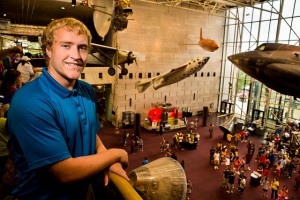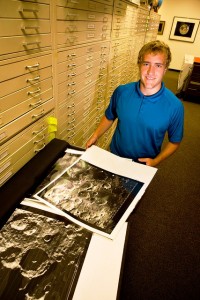Wesley von Dassow’s geological studies took one giant leap this summer.

Wesley von Dassow ’14 at the Smithsonian National Air & Space Museum in Washington, D.C.
Von Dassow ’14 (Sarasota, Fla.) interned with the Smithsonian National Air & Space Museum in Washington, D.C. There, he studied images freshly snapped by NASA’s Lunar Reconnaissance Orbiter Camera, identifying and cataloguing geological features of the moon. The information he generated could be used for research, educational programs, and in the museum’s exhibits.
A geology major, von Dassow worked shoulder to shoulder with the experts of the museum’s Center for Earth and Planetary Studies division. Learning how to recognize the moon’s various tectonic features, he says, was both the most exhilarating and difficult aspect of the internship.
“Some classes of the features looked very similar and on some occasions, extremely rare as they were, they could fool even the trained eyes of the professionals I was working with,” says von Dassow, noting that some of the features he studied had never been seen before.

Wesley von Dassow ’14 looks over Apollo era high-resolution photos of the lunar surface.
“I also contributed to finding that some of these features are in clusters that cover more distance on the moon than was ever thought before,” he says. “Being a student in geology, this was really exciting.”
Von Dassow had already garnered some hefty experience in the field: He spent last summer at a paleontological dig site with the Museum of the Rockies in Rudyard, Mont. He also participated in a summer interim course in which he and a group of Lafayette professors and students examined the geology of America’s western national parks. He says his coursework for his major “absolutely” fit with his internship at the museum.
“Having taken a class heavily focused on using ArcGIS (a mapping and spatial analysis program), I was able to contribute to the museum’s interactive exhibit that projects maps of the Earth and extraterrestrial bodies onto a globe,” he says.
He had a hand in several educational programs as well, such as the popular Mars Day event and an informational session about the planetary sciences for teachers.
Von Dassow has always been interested in planetary geology. His experience has steered him to pursue a career at a place like the National Air and Space Museum or NASA, where he can work in research, education, and science-related policy all at once. Working with top scientists in space exploration has also turned him on to even bigger possibilities.
“Having met two astronauts this summer and worked with a supervisor who just successfully passed the first round of the astronaut selection process, it makes living a childhood dream as that seem like more of a possible reality,” he says.
Von Dassow’s internship was supported by several stipends through Lafeytette Career Services.


3 Comments
Wesley was prepared with ArcGIS, so that he was ready to “hit the ground, RUNNING”. For the new Shale Oil frontier in petroleum exploration, I am learning Geographix (others use the PETRA program) a set of programs for doing quick “paperless” seismic, exploration work and for making prospects, “ready to drill”. How fascinating Wes’ moon plate tectonics work was this summer! Wow. And yes, I am a D.U., too. It must “run in the ‘Fraternity'”!
Great work by Wes and a credit to himself and our fraternity.
Comments are closed.